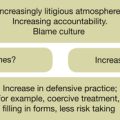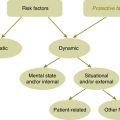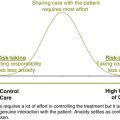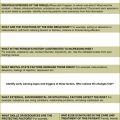Chapter 13 Risk of suicide
Although the risk of violence has seemed to generate more interest within mental health settings over the last few decades, the risk of suicide is one which general mental health clinicians are much more likely to have to deal with on a regular basis. The links between suicide and mental illness are much closer than those between violence and mental illness. It is a given that mental health clinicians should have a solid grounding in the assessment and management of suicide risk. Although there is no substitute for the experience gained from time spent assessing and managing suicidal patients, the assessment skills can be taught and there is a large body of knowledge available in this area.
Although suicide is a relatively rare event, it is a devastating event for those close to the person who died. The low base rate of suicide makes it difficult to predict such a tragedy. Suicide is generally, although not always, associated with mental illness and ‘effective treatment can reduce or abolish the risk of suicide in those cases’.1
Assessment
The assessment of suicide risk is similar to the assessment of other risks and includes a need for:
• a good rapport with the patient
• sensitivity, but also a willingness to ask difficult questions in order to be able to deliver good treatment.
Many junior clinicians (and some senior) are reluctant to ask patients too many questions about their suicidal intent, usually out of a mistaken concern that they will upset the patient. It is vitally important to remember that there is no evidence that assessing suicidality increases the risk in any way whatsoever. In practice, the process of catharsis is often healing and will reduce the risk in some instances. Once sufficient rapport has been established, clinicians should not avoid asking questions in as much detail as is necessary to fully assess the risk.
Assessment of suicide risk as an outpatient is essentially an exploration of the risk factors but, for an inpatient, there are a few added complications that need to be borne in mind. For inpatients, the assessment of risk should be repeated at clearly defined intervals. There should be agreement within the treatment team that as far as possible, the same clinician or clinicians should be responsible for reassessing the risk. For some inpatients, if the risk is assessed too frequently, the patient can become irritated with the process and may begin to withhold information. Finding the balance between sufficiently frequent assessments and not overdoing it can be difficult. Being mindful of times of increased risk, such as improving from a psychomotor retarded depression, shift changes, or at the time of discharge from hospital is important. It is also important to bear in mind that for some patients, the objective signs of improvement can in reality be an indication that the patient has attained some peace of mind by having finally decided how and when to complete the suicidal act. Once again, good and thorough assessment can help. Occasionally, staff on a ward may find a particular patient difficult and find themselves unwittingly creating the same sense of alienation that the patient experienced in their own home (malignant alienation2,3). This is highly dangerous and there should be processes set up to reduce the likelihood of this happening.
Relying on intuition or using the phrase ‘I have a gut feeling that they are suicidal’ is poor practice and should be avoided.
Further reading on assessment of suicide risk
New Zealand developed guidelines in May 2003 and these are available from: www.nzgg.org.nz.
• Click on ‘Publications’, then ‘Mental Health’. These guidelines are comprehensive, easily read and have appendices for assessment of patients in distress, assessment of risk of suicide and risk factors for suicide. The guidelines are written for the New Zealand culture but are applicable to most other cultures. They can be easily used in the clinical environment. ‘Appendix 2: assessment of risk of suicide’ has a very useful summary of questions that can be asked.
Goldney’s book, Suicide Prevention (Oxford University Press, 2008), is a recently published resource that is likely to become a major resource for any clinician learning about suicide. Chapter 8 explores assessment of suicidality in more detail than is possible here.
Risk factors for suicide
The risk factors for suicide can be divided into static and dynamic factors in the same way as for other risks. The difference for suicide is that the static factors are less useful in terms of giving some idea about the propensity for the risk behaviour than in the case of violence. However, the most important static factor is gender. Males commit suicide approximately four times more often than females. Suicide literally means ‘killing of himself’ and the reference to killing is a reminder of the aggression which is required to complete the act. Historically it was the older age group who were more likely to commit suicide, but in the last 3 decades youth between the ages of 15 and 24 have become an increasingly significant age group in suicide statistics. Although suicides in the family are of some importance, as are some developmental factors, the most important factors are the dynamic ones of mental illness and substance abuse. A consistent finding in psychological autopsies is that 80–90% of people who commit suicide had a mental disorder, particularly depression and often with co-morbid alcohol use or abuse.4 The severity of the mental disorder is also linked to the likelihood of the suicidal act being successful. Any mental disorder which has a mood component to it will lead to an increased risk of suicide. This is especially the case for depression of course, but bipolar disorders and schizophrenia also rank highly.
Alcohol, which is a depressant drug, is of great relevance in suicide. Up to 40% of patients with alcohol dependence will attempt suicide and up to 7% will die by suicide.5
Interestingly, cannabis abuse does not seem to be associated with an increased risk of suicide.
There is likely to be an experience of desperation, hopelessness, abandonment, rage, self-hatred or anxiety.6,7 Desperation seems to be of greatest import in this list of emotions. A sense of being trapped and of there being no way out is often present when the suicidal intent is high.8 If a patient describes feeling alienated from his friends, family or himself, the risk will be higher. There is some recent evidence that a suicide syndrome may exist in its own right separate to suicide being driven by a mental disorder.9 This highlights the importance of the emotions of desperation, rage and so forth, which are not always present in depression, so the possibility of a suicide syndrome is a reminder to look for these when assessing for suicidality.
If a friend or relative has recently killed themself, the risk is also raised.
Standardised rating scales have been developed to rate suicidal intent10 but have not found widespread usage at this time.
Management of suicidal risk
Some clinicians still use ‘safety contracts’ to manage the suicidal patient. These are agreements made with the patient who ‘guarantees their safety’ over a period of time. There is no evidence that these are of any benefit and current practice is that they should not be used either for acute or chronic suicidality.11, 12, 13
Within most clinicians’ careers, they will have a patient who expresses suicidal intent but with a timeframe added. For example, ‘I’ll be dead by March 23’ or ‘I won’t see this Christmas’. This is a difficult situation which requires an exploration of the meaning behind the statement as well as consideration of transference and counter-transference responses. Some patients may make a statement such as, ‘If you don’t admit me, I will kill myself’. The anxiety and counter-transference provoked can easily be raised to such an extreme that useful interventions become impossible. It is important to remember that these are communications from the patient that need to be explored and cannot be managed until their meaning becomes clear. The initial anxiety on the part of the clinician needs management in the usual way, as described in Chapter 6. In these situations, experience is invaluable and, if this is a new experience for a clinician, the support and advice of colleagues should be sought. Further reading on this topic can be found in Gutheil’s article on the subject.14
The risk factors for suicide appear in Table 9.1, pages 80–81.
1 The Assessment and Management of People at Risk Of Suicide 2003 New Zealand Guidelines Group and Ministry of Health. Online. Available: www.nzgg.org.nz (accessed 19 Nov 2009).
2 Morgan H.G. Death Wishes: The Understanding and Management of Deliberate Self-harm. Chichester: Wiley; 1979.
3 Watts D., Morgan H.G. Malignant alienation. Dangers for patients who are hard to like. British Journal of Psychiatry. 1994;164:11–115.
4 Goldney R.D. Suicide Prevention. Oxford: Oxford University Press; 2008.
6 Hendin H., Maltsberger J.T., Szanto K. The role of intense affective states in signalling a suicide crisis. The Journal of Nervous and Mental Disease. 2007;195(5):363–368.
7 Hendin H., Maltsberger J.T., Haas A.P., Szanto K, Rabinowicz H. Desperation and other affective states in suicidal patients. Suicide and Life Threatening Behaviour. 2004;34(4):386–394.
8 Williams J.M.G., Crane C., Barnhofer T., Duggan D. Psychology and suicidal behaviour: elaborating the entrapment model. In: Hawton K., ed. Prevention and Treatment of Suicidal Behaviour. Oxford: Oxford University Press; 2005:71–90.
9 Fairweather-Schmidt K.A., Anstey K.J., Mackinnon A.J. Is suicidality distinguishable from depression? Evidence from a community-based sample. Australian and New Zealand Journal of Psychiatry. 2009;43:208–215.
10 Bouch J., Marshall J.J. Suicide risk: structured professional judgment. Advances in Psychiatric Treatment. 2005;11:84–91.
11 Rudd M.D., Mandrusiak M., Joiner T. The case against No-Suicide Contracts: the commitment to treatment statement as a practice alternative. Journal of Clinical Psychology: In Session. 2007;62:243–251.
12 Bateman A., Fonagy P. Mentalization Based Treatment for Borderline Personality Disorder. Oxford University Press; 2006. p 48.
13 Boyce P., et al. Summary of Australian and New Zealand clinical practice guidelines for the management of adult deliberate self-harm. Australasian Psychiatry. 2003;11(2):150–155.
14 Gutheil T.G., Schetky D. A date with Death: Management of Time-Based and Contingent Suicidal Intent. American Journal of Psychiatry. 1998;155:1502–1507.







